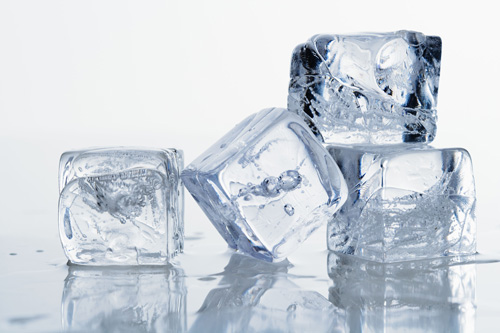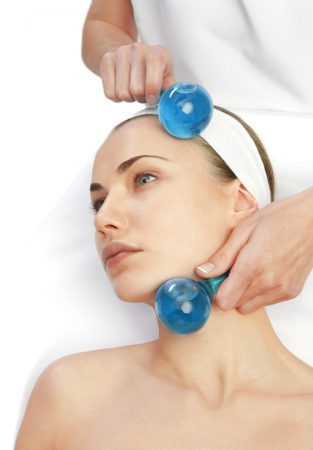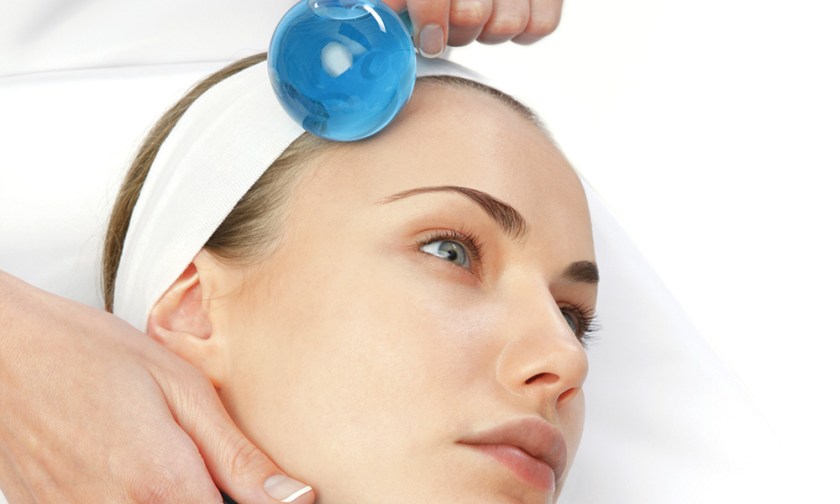A new paradigm for the treatment of inflammatory skin conditions. By Matoyla Kollaras*.
Inflammatory skin conditions, which present as erythema (redness), oedema (swelling), venous congestion (blood stagnation), sensitivity and infection (bacterial, fungal), are often made worse by the presence of heat.
Unlike the colder months, which tend to make skin dry, tight and flaky, it is well known that the summer heat and UV exposure can trigger and/or worsen skin diseases such as rosacea.
So why do many therapists still treat heat with heat?
With summer well and truly on its way, perhaps it is time to rethink your treatment strategies and embrace a new paradigm for the treatment of inflammatory skin disease that embraces cooling; treatments with beneficial phytonutrients and compounds to reduce redness, swelling and infection.
GOOD COP, BAD COP
Inflammation is one of the body’s primary defence mechanisms to fight, weaken, destroy and remove foreign material, metabolic by-products and debris.
It enables the body to remove damaged cells, neutralise toxins, and fight bacteria, fungi and viruses.
The main physiological components of inflammation are redness, pain, heat and swelling.
Pain is the nervous system’s response to heat and irritation when the body initiates the inflammation process to “burn” away irritants. Inflammation then goes through several stages before finally allowing the body to heal.
Like a police force that is prompt and efficient, inflammation is usually our friend. However, when the process continues, and so getting out of control, it throws things out of balance, becoming a problem that can result in a chronic state of disease that can cause significant damage.
RED-FACED

Inflammatory skin diseases are the most common problem in dermatology, manifesting as occasional rashes accompanied by skin itching and redness, to chronic conditions such as rosacea, seborrheic dermatitis, dermatitis (eczema), rosacea, and psoriasis.
Skin inflammation can be categorised as either acute or chronic. Acute inflammation can result from exposure to UV radiation (UVR), allergens, contact with chemical irritants (soaps, hair dyes, skincare products etc.) and skin treatments.
This type of inflammation is typically resolved within 1-2 weeks, with little accompanying tissue destruction.
In contrast, chronic inflammation results from a sustained immune cell-mediated inflammatory response within the skin itself. This inflammation is long-lasting and can cause substantial and serious tissue and DNA destruction.
The process of skin inflammation is complex and is still not completely understood. When the skin is exposed to a “triggering” stimulus, such as UV radiation, an irritant (eg. soaps, skincare products or fragrances), or to allergens, the cells in the skin produce a variety of inflammatory “hormones” called cytokines and chemokines, as well as enzymes, free radicals, and various other chemicals.
The end result of the initial triggering event is the amplification of a large inflammatory response that, while designed to help the skin fight external pathogenic onslaught, actually causes considerable compromise to the skin’s barrier and its immune defence system, thus placing the skin in a cycle of continual inflammation, skin damage, collagen and elastin degradation, weakened capillary integrity, hypertrophy and end-stage disease, such as skin cancer.
CAUSES OF INFLAMMATION
For the sake of this article, we are referring to skin conditions and symptoms that present as RED, HOT, SWOLLEN AND PAINFUL, regardless of the disease cause behind it. Excessive and chronically inflamed skin can be due to:
- ROSACEA – one of the most common causes of redness in the skin
- LUPUS – often seen at a “butterfly” rash
- ACNE – generally due to toxic, cystic and infected acne lesions
- SEBBORHEIC DERMATITIS
- PSORIASIS
- ECZEMA AND DERMATITIS
- COUPEROSE
- EXCESSIVELY DRY AND DEHYDRATED SKIN – intrinsic and extrinsic factors that can cause and/or exacerbate chronic skin inflammation
- EXTREME WEATHER AND ENVIRONMENTAL CONDITIONS
- EXCESSIVE ALCOHOL
- POOR DIET
- LIFESTYLE
- STRESS – triggering elevated cortisol levels in the body, which have a direct negative impact on skin health
- MEDICATIONS
- SYSTEMIC DISEASE
KEEPING IT COOL
The management of rosacea and other inflammatory skin conditions is often a perplexing prospect due to the variables (health, diet, lifestyle, stress etc) and affect even the most calculated aesthetic treatment plans.
Furthermore, most therapists tend to work with the knowledge/training, tools and product on hand, which are often limited, and hence often perpetuate skin reactivity and inflammation by utilising treatments such as massage, heating devices, steam, and ingredients such as acids, vitamins A and C.
With all this in mind, therapists must look to new paradigms in the treatment of inflammation, and “explore variables in philosophy, modalities, product knowledge and selection; along with the integration and expansive skin assessment.
The good news is that some of the most logical and simplest measures can wield impressive results, and although in many cases we cannot cure the disease, we most certainly can reduce the response, reverse the damage and keep symptoms under control or in remission.
DEFUSE FLUSHING

Because many conditions that cause redness on the face can’t be cured, it’s important to take steps to prevent facial flushing.
There are, however, three very important points that I would like to emphasise when it comes to treating all diseased and challenging skin conditions:
- WHEN TREATING SKIN, ALWAYS TREAT THE MOST URGENT ISSUE FIRST. This should be the mantra of every therapist. You will find that once you start treating the most urgent issue first (for the case of this article, it is the inflammation), the associated conditions will improve, and the general wellbeing of the skin will begin to recover.
- IS THE CONDITION EXCESSIVE OR DEFICIENT? It is extremely important to differentiate between the two. For example, teenage acne tends to be in an excessive state and therefore treatment can be more active, more frequent, and reductive in nature. On the other hand, in the case of rosacea, the skin only appears to be in an excessive state due to its manifestation. Indeed, because rosacea is a chronic issue, the skin is in fact in a deficient state with an outward expression of excessive symptoms (redness, swelling etc.). In this case, treatments should be aimed at building the health and immunity of the skin, while simultaneously reducing symptoms such as inflammation, infection etc. Therefore, at all costs avoid highly active treatments and products that challenge and/or tax the skin.
- WHERE THERE IS HEAT, THERE IS FIRE. Therefore, always treat heat with cold, and put out fire with water. Never treat heated skin conditions with oil, which will create a barrier that will have the skin “cooking” further underneath. Water not oil puts out fire, and rehydrates dry, parched skin.
COLD WATER COMPRESSES
Touch your client’s skin. Does it feel hot to the touch? Does your client complain that heat aggravates their skin? Does your client’s skin feel tight, hot and dry after a shower?
Why, then, should you treat your client’s skin with heat?
Hot towels and steam/vapourzone should not be used on inflammatory and sensitive skin conditions such as rosacea, lupus, toxic acne etc.
In addition, any water used in treatments should be tepid to cool in temperature – in other words, the entire facial should be cool to the touch.
Cold compresses and herbal poultices are an excellent tool in the treatment of inflamed skin.
The journal Archives of Dermatology found that a cold compress helped to alleviate symptoms of rosacea in around 70% of patients.
The ice compress helps to reduce facial flushing and inflammation and is viewed as a safe natural treatment for inflammatory skin conditions.
These compresses may be applied on top of a soothing mask or and/or at the end of the treatment for comfort and to reduce inflammation. It also will make mask removal easier.
TO MAKE A COLD COMPRESS …

Put some ice cubes or crushed ice into a bag and wrap in a clean towel. Place the compress on the red area of skin. Hold for a few minutes and then remove for a few minutes. You can repeat this a few times.
If you don’t have any ice, you can dip a towel in cold water and hold to the skin to reduce facial redness.
I highly recommend that you add some Dead Sea Salt to the water and to herbal poultices. Minerals such as zinc, magnesium and selenium are powerful antioxidants and anti-inflammatory agents.
In addition, zinc is the first mineral that heads to an injured skin site; all diseased skin, including acne, is injured.
Remember, it’s important to never put ice directly onto skin.
Cold compresses offer four main benefits against:
INFLAMMATION: During inflammation, there is vasodilation, or blood vessels expanding. Cold compress will cause the opposite, a vasoconstrictive response, reducing blood flow and rerouting the blood circulation away from the site, internally.
OEDEMA: Cold compresses have a hydrostatic ability, and so will cause the transfer of swelling due to fluids, thereby reducing oedema.
IMMUNITY: Cold compresses can boost the immune system by stimulating immune cells such as T-cells, T-lymphocytes and cytokines.
PAIN: Cold compresses cause the body to release endorphins – hormones with proven pain-fighting capacities.
COLD DEVICES
There are a variety of hand-held devices made of glass, ceramic or metal, some filled with cryogenic liquid material, which will cool skin and provide vasoconstrictive activity, thus reducing inflammation, oedema and pain.
Ideally these should be used with hydration/water-based mask or an anti-inflammatory gel for easy and soothing glide.
Note that cold therapy should be applied in short sessions and for no longer than 10 minutes at a time.
Devices include:

- Microcurrent golden spoons
- Cryogenic cooling globes (pictured above at top of page)
- Cold “hammer”
- Stainless steel rollers
- Cold marble stones in a disc shape
- Crystal face wands
- Gemstone rollers in jade or amethyst
- Hand-held icing wand
MAGIC OF MASSAGE
Massage is beneficial for diseased skin, as it can help to promote blood flow, thus reducing venous congestion (blood stagnation) and oedema (swelling), while simultaneously eliminating toxic by-products.
However, friction will heat the skin and cause further inflammation, therefore traditional facial massage protocols using your hands are not recommended. Instead we recommend these three modalities:
- COOLING DEVICES – see previous notes. Cooling devices such as Cryogenic cooling globes allow the therapist to cool the skin through massage. The cooling globes are extremely soothing and calming both on the skin and for the client.
- PRESSURE-POINT THERAPY – to help promote blood flow, while reducing stagnation and alleviating pain. Look for pressure points along the body’s meridian pathways, as per Traditional Chinese Medicine. Pressure-point therapy also helps to calm the client and reduce stress. Stress is implicated in worsening inflamed and sensitive skin conditions.
- LYMPHATIC DRAINAGE – the lymphatic system is part our circulation and vital to the immune system. A network of lymphatic vessels carries a clear fluid called lymph (from Latin lympha meaning water). It is important that this fluid is able to circulate and be kept free of toxic build-up, as the lymphatic vessels are indispensable in collecting waste products. All of this plays an important role in the maintenance of healthy skin. Clients with conditions such as rosacea, toxic acne and atopic (genetic) eczema dermatitis are prone to constant lymph node swelling. This inflammatory response causes the skin to become red, hot and itchy. This disease causes constant scratching of the skin, depleting the skin’s barrier and creating a cascading effect of chronic inflammation, while stress levels rise, causing another acute reaction. Lymphatic drainage removes the build-up of irritation under the skin, and by clearing the lymph nodes that are swollen and moving stagnated blood, we can relieve the itchiness, redness, heat and oedema.A manual lymphatic facial is deeply relaxing, one of the best facials for clearing the skin, reducing stress and promoting a sound night’s sleep. However, lymphatic drainage facials should only be performed by therapists who have a sound knowledge of the lymphatic system and its topography, and correct massage protocol.
MAGIC OF MASKS
Highly recommended are the ALIGINATE MASK AND COLLAGEN SHEET MASK. Both must be used with cold water to deliver immediate relief for inflamed, irritated and sensitive skin. In addition, the collagen sheet mask provides hydro-boosting properties – water putting out fire.
LED and INFRARED LIGHT THERAPY
These are non-invasive treatment tools for numerous acute and chronic conditions, providing natural pain relief and aiding faster healing.
Light therapy works by energising compromised cells when there is an injury, disease or the body is slower to heal as a result of age or a condition such as diabetes.
The cell is the building block of the body, and if cells are able to function optimally, the body will heal itself.
Light therapy energises compromised cells and increases blood flow and other cellular functions using highly beneficial wavelengths of LED light.
LED therapy will help to stimulate healing, relieve pain, swelling and inflammation, remove blood stagnation and increase lymph vessel diameter to ensure clearing of waste products and inflow of oxygen, nutrients and medication concentrations in the areas treated.
The proven effects from red light therapy are: • Increased production of ATP in the mitochondria – setting of 660-680 nm red wavelength • Increased immune system activity • Increased cellular regeneration– the wavelength of 630-670 nm raises the potential for macrophages, fibroblasts and keratinocytes• Prevention of cell death for traumas treated within 4-6 hours • Clearing of inflammation and increased lymphatic activity • Increased circulation • Systemic effect and reduced excitability of nervous tissue (pain relief) • Regulation of collagen production • Skin rejuvenation – the orange-red range of 560–780 nm is also effective for skin rejuvenation treatments related to rehabilitation of microcirculation and encouraging fibroblast activit.
THE RIGHT STUFF
When choosing products for the treatment of inflammatory skin conditions choose ingredients that specifically target inflammation (most importantly), barrier damage and possible infection.
What makes an ingredient a “good” anti-inflammatory candidate depends primarily on the ability of the ingredient to block key “inflammatory mediators” produced by skin and immune cells.
Two of the most important inflammatory mediators involved in skin disorders are TNF-alpha, as mentioned above, and PGE-2.
While TNF-alpha plays a key role in psoriasis, PGE-2 is a major participant in all types of skin inflammation, and is perhaps the most important hormone “mediator” involved in sunburn.
Pain, redness and swelling are all due, in part to PGE-2, and studies conducted over many years have implicated PGE-2 as a key participant in the development of skin cancer.
Further, PGE-2 suppresses collagen formation in the skin and thus, participates in photoaging. Antioxidant compounds that can prevent the production of PGE-2 could be extremely useful in preventing skin aging and in reducing the risk of skin cancer.
These are useful ingredients in the treatment of inflammation:
ANTI-INFLAMMATORY AGENTS – St. John’s wort (Hypericum), niacinamide (vitamin B3), Palmitoyl tetrapeptide-7, gingko, bisabolol, allantoin, calendula, cucumber, aloe azulene, turmeric, selenium, pycnogenol, copper, liquorice.
ANTIOXIDANTS – One antioxidant is not better than another. All antioxidants are highly useful ingredients and they all have their own therapeutic benefits. However, studies have shown that not all “antioxidants” have anti-inflammatory activities, and that some of the weakest antioxidants have the best anti-inflammatory and anti-ageing effects on human skin cells. In any case, it is smart to select antioxidants with anti-inflammatory actions, and antioxidants which won’t further aggravate the skin – for example vitamins A and C are exceptional antioxidants but they can also trigger inflammation, and as such are contraindicated in inflammatory skin conditions. Resveratrol, vitamin E, green tea, Palmitoyl oligopeptide, alpha lipoic acid, purslane, quercetin, magnesium, calcium, Quintescine™ peptide, Omega 3 and 6.
SKIN AND BARRIER REHABILITATION – centella asiatica, seabuckthorn, hyaluronic acid, oligoaccharides, shea butter, ceramides, zinc, squalene, beta-glucan, Venuceane™, glycoproteins, probiotics, coenzyme Q10, chlorophyll, Echinacea, jojoba
BACTERIOSTATIC AND ANTI-MICROBIAL AGENTS – Dead Sea salt and mud, sulphur, thyme extract, marjoram extract, oreganum extract, cinnamon extract, lichen extract, propolis, tremella fuciformis (mushroom) extract, chlorphenesin
BLOOD MOVERS (for venous congestion) – caffeine, arnica, capsicum, vitamin K
BROAD SPECTRUM SUNSCREEN- physical sunscreen zinc oxide, titanium oxide with UVA, UVB and infrared protection
AVOID: Retinol (vitamin A), ascorbic acid (vitamin C), acids (AHA and BHA), alcohol, witch hazel, essential oils (eg. eucalyptus, peppermint), menthol
CLIENT HOME CARE ADVICE
- Avoid harsh soaps, exfoliants and chemicals that can cause skin irritation and redness
- Always remove makeup before going to bed to prevent a build-up of dirt and bacteria
- During sunny days, wear a wide-brimmed hat, keep your face in the shade, and use physical broad-spectrum sunscreen (UVA, UVB and infrared protection)
- Avoid foods and drinks that can trigger outbreaks of rosacea. Some of these are spicy foods and alcohol
- Reduce stress in your daily life to avoid skin redness
- Seek fitness without the flush – avoid strenuous and stressful exercise, opting instead for walking, tai chi, swimming, light weights etc
- Avoid long hot showers and baths, sauna, spa etc
OUT OF CONTROL?
Out-of-control skin conditions are often the result of genetics, lifestyle, stress, and inappropriate products and protocols.
Most important is to avoid treatments that exacerbate the inflammation and especially to avoid applying further heat to affected areas.
In this article, I have outlined a number of these easy-to-use therapies but, like all advice given, you should always remember if the condition persists, to recommend your client to a dermatologist at their earliest convenience.
- Matoyla Kollaras is a qualified therapist and the director of Skin Factors, distributor in Australia of Christina Cosmeceuticals and AHAVA Dead Sea skincare. She is passionate about skin health and treatments and is highly committed to constantly staying at the forefront of research and new advances in skin science and cosmetic ingredients.




